
Emerging Plays
New oil plays are focused on the stacked pay of the Midcontinent’s Meramec, Springer and Canyon Lime. In the Permian Basin, a prospect is to be drilled soon in the lightly explored Orogrande Basin.
Article by Nissa Darbonne
Photography by Tom Fox
A lineup of cuttings reflects the formations Cactus Drillings’ Rocket Rig 140 is drilling through for Newfield Exploration Co. at its Laura 1H-17x near Okarche in Kingfisher County, Oklahoma.
Traveling through Oklahoma’s stratigraphy, one can stumble over as many as 7,500 formations. “Most have names; in some cases, several,” the Oklahoma Geological Survey explains in an oil and gas FAQ page. The abundance of nomenclature is the result of many factors, the OGS adds, including simply that, at times, “geologists may disagree.”
The state also hosts more than 3,000 field designations. To simplify, strat-trippers can cheat down to the 300 formations that have had 10 or more well completions. Among them is the Woodford Shale, which Newfield Exploration Co. proved commercial from fracked horizontals beginning in 2005 where the pay is gassy in the Arkoma Basin of southeastern Oklahoma.
The Woodford has since given birth to more plays, including two new headliners—Stack and Scoop—both in a liquids window in the eastern Anadarko Basin in central Oklahoma. Each is an acronym for a geographical—rather than a geological—reference. Both target the liquids-rich, Upper Devonian-age Woodford. But Stack also targets a shale horizon in the overlying, Mississippian-age Meramec group that is mostly carbonate; Scoop’s secondary target is a shale horizon in the overlying—also Mississippian in age and mostly sandstone—Springer group.

From this and other new oil drilling in the state, Oklahoma’s production has grown from a low of about 150,000 barrels (bbl) of oil a day in 2005 to some 370,000 this past summer, according to the U.S. Energy Information Administration. The peak was about 500,000 in 1984.
In 2000, the EIA estimated, based on a poll of Oklahoma-well operators, that the state had 610 million barrels (MMbbl) left to give after having produced more than 14 billion. The OGS’ Dan T. Boyd reported in the fall of 2002 in Oklahoma Geology Notes that, based on production since the estimate, the state had 477 MMbbl left and would be finished by 2010. The EIA estimate was likely too low, he added, but “the bad news is that the end is in sight.”
That was based on conventional vertical production, though. Producers are now making oil from source rocks and with horizontals.
Newfield's Woodford/Meramec
Lee Boothby remembers having few expectations of Oklahoma’s oil future as far back as 1983, when he studied some of the state’s old fields in a summer internship before completing his petroleum-engineering degree. Boothby is now Newfield’s chairman, president and chief executive. Driving back to LSU at summer’s end, Boothby recalled, “I got to Norman and my opinion, heading south, was that this isn’t the end of the world, but you can damn sure see it from here.
“I remember thinking, ‘I’ll never be back here with all of that old stuff.’”

But he is back—since 2002—and Oklahoma is one of Newfield’s most prized oil members in its portfolio. The company, which had been best known as an offshore-only producer since its formation in the late 1980s, entered the onshore U.S. in early 2001 with an Anadarko Basin purchase of Lariat Petroleum Inc. from Randy Foutch. The deal included more than 1,300 wells producing mostly gas. Foutch moved on, building and selling another E&P and then forming Laredo Petroleum Inc., which is focused in the Permian Basin.
At the time, as the Barnett Shale in North Texas was proving to be commercial, Newfield began to look east of its Anadarko Basin leasehold—at the Woodford Shale in the Arkoma Basin—culminating with the horizontal discovery, Blevins 3H-9, in early 2005. It proceeded to drill 380 horizontals, HBPing its position.
It was dry gas; at the time, gas was a prized commodity. “We were short American natural gas,” Boothby noted. By 2009, though, there was plenty.
Vice President, Midcontinent
Newfield Exploration
Newfield had already begun producing liquids-rich pay from the Granite Wash in western Oklahoma. It looked at the liquids-rich Woodford Shale in central Oklahoma. Some of what it acquired from Foutch was in Golden Trend Field, where oil wells were still flowing on their own from commingled Viola, Hunton, Woodford and Sycamore—mostly from the Woodford.
Newfield called the new Woodford play “South Cana” at the time. Continental Resources dubbed it “Scoop” in 2012 for “south-central Oklahoma oil province” and the name stuck at the intersections of Grady, McClain, Garvin and Stephens counties southwest of Oklahoma City. Newfield’s early wells were IPing more than 1,000 barrels of oil equivalent per day (boe/d) of between 16% and 69% oil.
In November, however, Newfield was planning to move three of its six Scoop rigs to join three that are drilling its new “Stack” play for combo Woodford and Meramec oil just north, in Canadian and Kingfisher counties. “Stack” is derived from “Sooner Trend (oil field), Anadarko (Basin), Canadian and Kingfisher (counties).”
Newfield drilled a Woodford discovery, Rock Island 1H-14, in Stack in 2011 with a one-section lateral for about $9.6 million, some 15 miles updip of the next-nearest Woodford well in Cana Field. “It was better than forecast,” Boothby said. “We liked what we saw. We used that as our early test case of a well in the oil window.”
The log also indicated strong shows in the Meramec, which appears at about 8,400 feet in the area and is some 275 to 475 feet thick. About 50 feet later, after encountering a thin section of Osage, the Woodford is up to 150 feet thick.
“We quickly drilled another well, cored the [Meramec] interval and determined it was saturated with mobile oil.” Undercover for two years, the company leased. Keeping it quiet within industry and in earnings calls was difficult. “It was a time when people were wondering if we had enough inventory,” Boothby said.
The company’s stock price had declined 42% in two years leading into August 2013. It announced Stack in November 2013 with seven wells online, demonstrating estimated ultimate recovery (EUR) of between 800,000 and 1 MMboe, 40% oil and 30% NGL. Heading into August 2014, shares were up 82% for 2014 before crude oil prices tumbled below $70.
Stack plans
With three years of Stack drilling now, it has 30 producing wells—about half from the Meramec; half from the Woodford—in the play. Its IPs have averaged 900 boe/d, and 30-day production has averaged 640 boe/d from two-section laterals. Its working interest in these is 93%.
The Meramec wells have been landed in a shale member in the upper portion of the group. The company is currently testing landing laterals now in both the upper and lower portions of the Meramec.
“We’re focusing on HBP this and next year,” Boothby said, “and we will start testing staggered spacing that we may use when we move to development. We believe there will be multiple intervals in the Meramec—two or three—that get developed.”
Its position in Scoop, where it has 57 operated wells online, is more than half HBPed; in Stack, less than a third. Delineation of the Meramec and Woodford in its Stack isn’t challenging, though. “There was a lot of well control we used to identify the target areas,” Boothby said. The Sooner Trend Field discovery was in 1945, and more than 13,000 wells have been drilled in Oklahoma to at least as deep as the underlying Hunton, which appears throughout the state.
“We’re getting good results and we’re accelerating activity. We have 150 to 200 wells to drill across the two plays during the next three to five years to HBP the positions.”
Woodford is the source rock for Meramec production on the eastern flank of the basin. “Some intervals may be self-sourcing, but the dominant source is the Woodford,” Boothby said.
In the time of the Meramec group’s formation, there were as many as six depositional cycles. “We know there is a 700-foot-thick, mobile, oil-saturated window from the top of the Meramec to the base of the Woodford and all of that is prospective. It’s a question of just how many layers we can ultimately develop. It could be two, three, four or five, but multiple horizons will get developed.”
The Oklahoma Geological Survey deemed the Meramec group a carbonate; Newfield’s laterals are in a shale section. “We took core to the state of Oklahoma to get the designation. It is a shale,” Boothby said.

The finding was surprising, he added. “Despite all the well control, there weren’t many geoscientists expecting to encounter the Meramec as having a shale interval. Most people thought it was a carbonate.”
The reason for the previous designation was that, north and south of Stack, the Meramec group includes the Mississippian limestone play—the one ongoing in northern Oklahoma and southern Kansas. South of Stack, Meramec is known as Sycamore—again a limestone. “The facies do change but, in our acreage block, it’s a shale,” Boothby said. “There are some variations of lithology, top to bottom, but it is a shale.”
The finding was also important in how the target could be produced, Boothby added: To date, the state has allowed two-section laterals only in shale plays.
Stress regimes across Stack vary, but Newfield is finding good results with laterals with a north/south and south/north strike. The company also operates in the Bakken, where stress suggests an optimal strike that is more angular, “but, in the Anadarko and Arkoma Woodford, the north/south orientation is the best.” And it is the most efficient, he added. “I like that orientation.”
Marathon Oil Corp., which has some 100,000 net acres in Stack, has also tested Osage in the area, reporting to investors that it has found “encouraging early results.”
Boothby said of Marathon’s and others’ Osage trials, “if they have success, we will probably have the Osage to test at some time. Each well we drill adds that to the database. So we’re gaining valuable information as we move into development mode.”
Springer news
Back to Scoop, among Newfield’s 57 operated wells there, one is in the mostly sandstone, Springer group—specifically the Goddard Shale member—overlying the Woodford. Its one-section Jarred 1-16H had an IP of 1,950 boe/d and a 30-day average of 1,220 boe/d, 81% oil.
Continental Resources Inc. began testing the Springer in its Scoop position in 2012 and revealed the new play last year in a September 17 analyst meeting. (Marathon dropped the “Springer” name in a September 3 press release and investor presentation. Lee Tillman, president and CEO, said the company is looking at the Goddard and Boatwright shales within the Springer group that appears in both its Scoop and Stack leasehold.)

By September, Continental’s Springer discovery well, which had been online for 20 months, and its two confirmation wells had made a combined 640,000 boe. To date, the company has announced results on 15 Springers with IPs that averaged 1,230 boe/d and 30-day rates of 830 boe/d, 67% oil and 17% NGL.
Boothby said of the Springer, “We are very excited about the wells that are being drilled there. You’re generating these exciting results with one-section laterals. That tells you the producibility of that interval is very, very good.”
Newfield has 275,000 net acres in Scoop and Stack—with 190,000 of these in Stack—and hasn’t stated yet the acreage prospective for the Springer within Scoop. “We will put that out after we’ve drilled more wells,” Boothby said. “But, in general, I would say the Springer covers a large portion of the Scoop acreage. Continental has circled it [in its reports] and there is quite a bit of well control.”
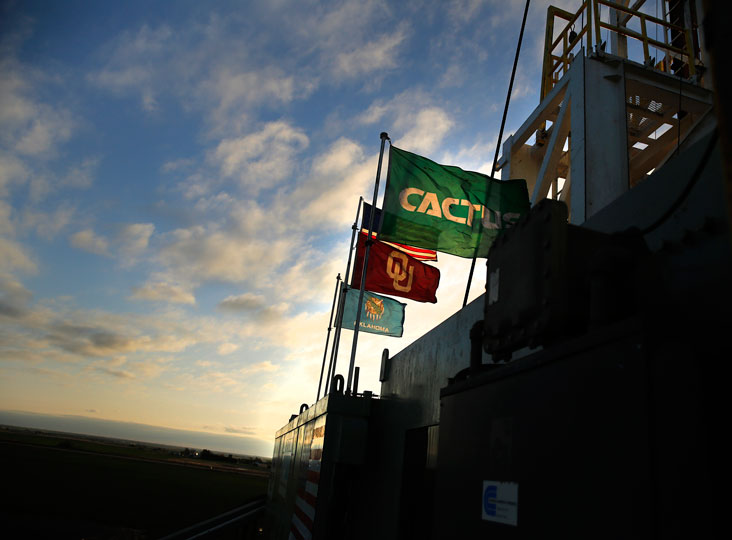
Sub-freezing sunrise at Cactus Rocket Rig 140, drilling Newfield Exploration Co.'s Laura 1H-17x well near Okarche in Kingfisher County, Oklahoma.
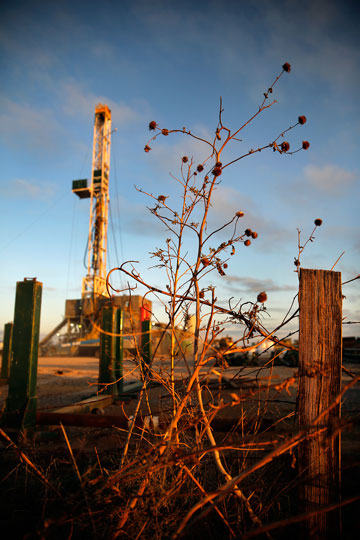
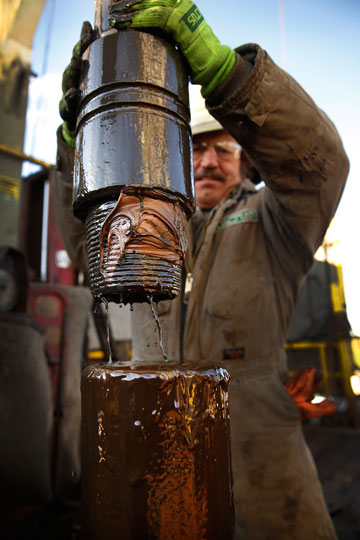
Cactus Drilling Co. floor hand Mark Skaggs connects a new stand of pipe.

Cactus Drilling driller Chad McDaugale runs a new segment of pipe.
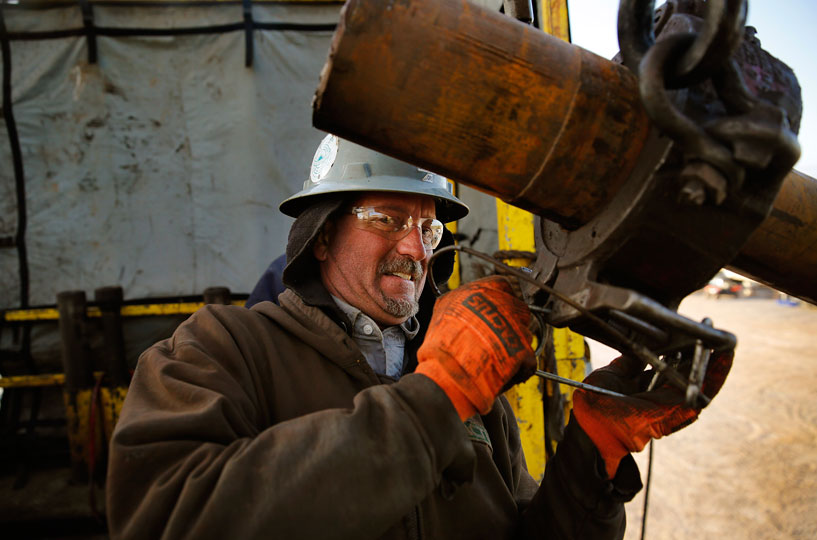
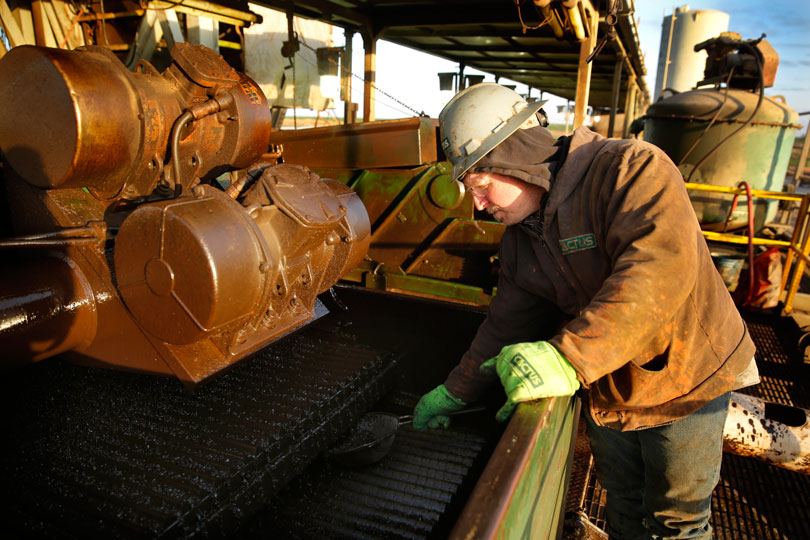

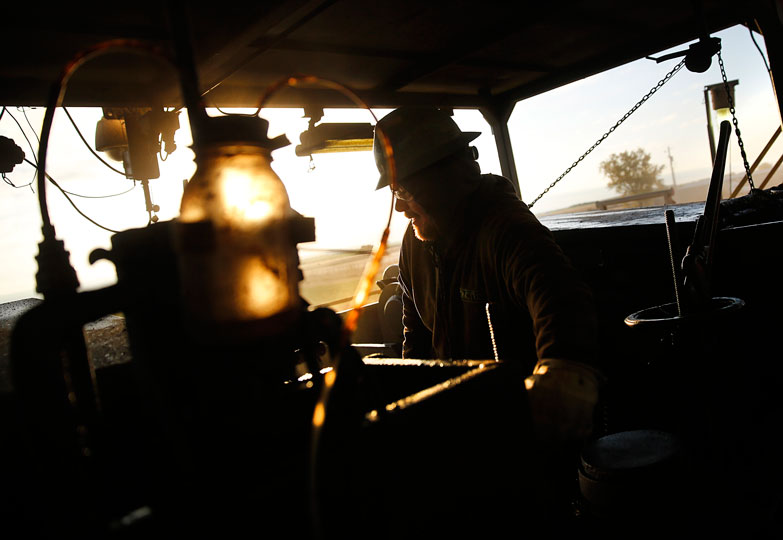
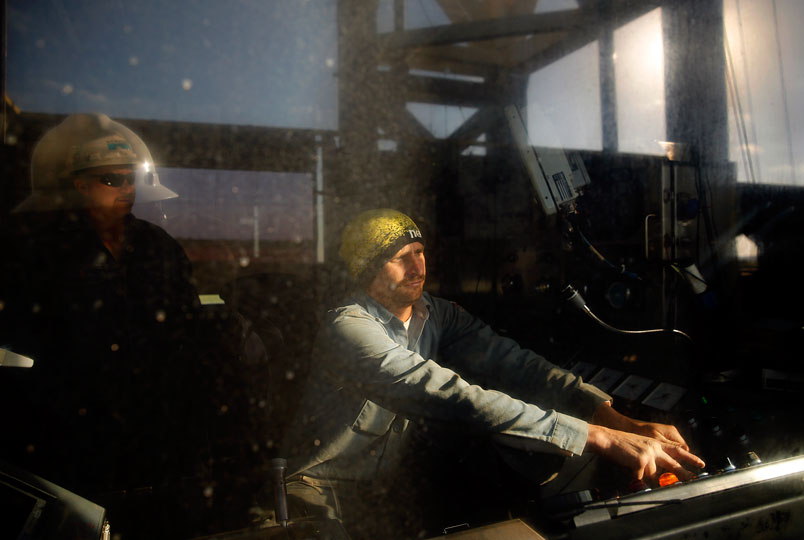

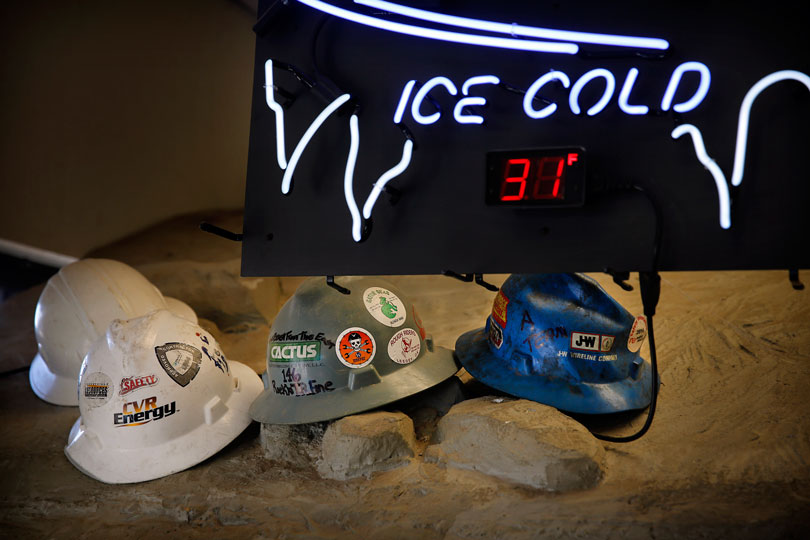
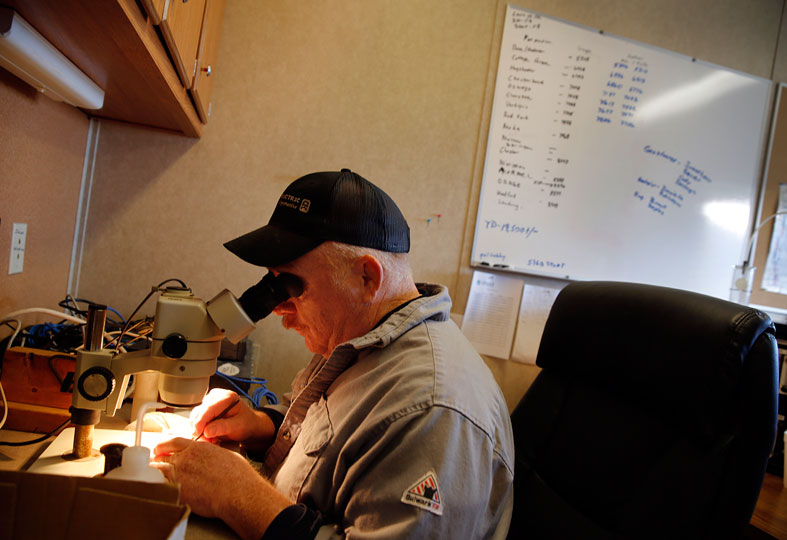
Mud logger and field geologist Bobby Brinlee studies cuttings from Cactus Rocket Rig 140 with a microscope at Newfield Exploration Co.'s Laura 1H-17x well site.
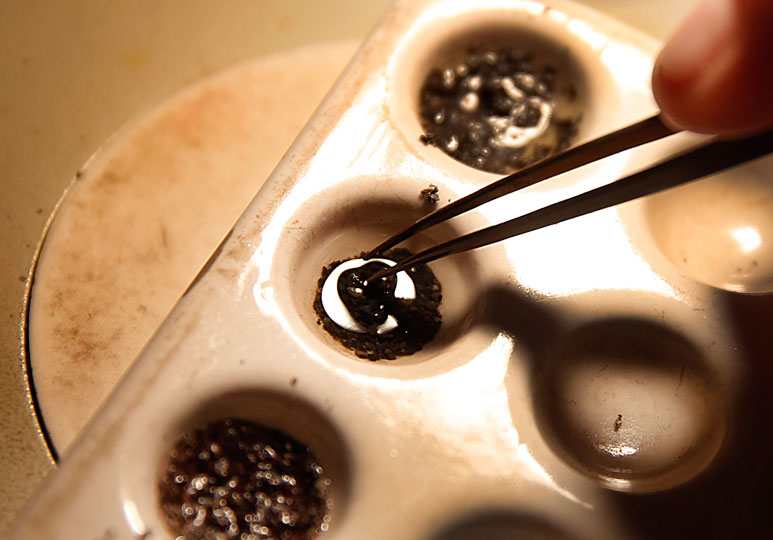

The Weatherford frac operation setup for Newfield Exploration Company's Knauss 1H-1X well site outside Kingfisher, Oklahoma.
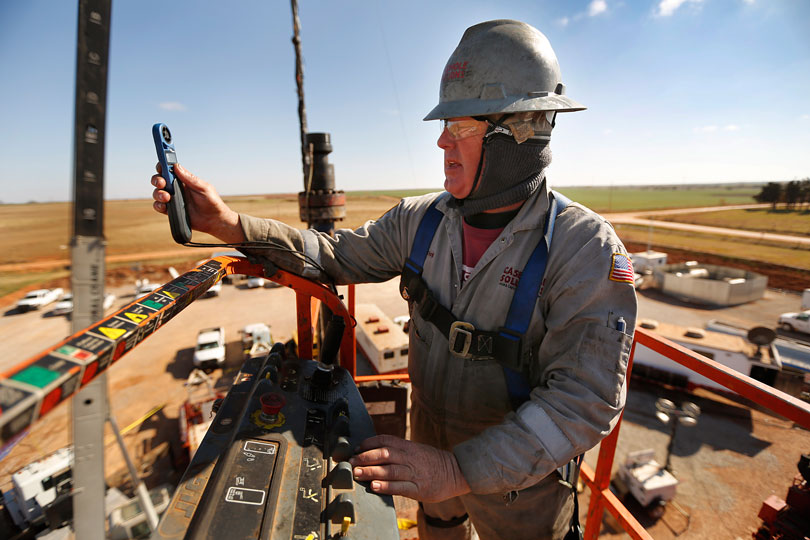
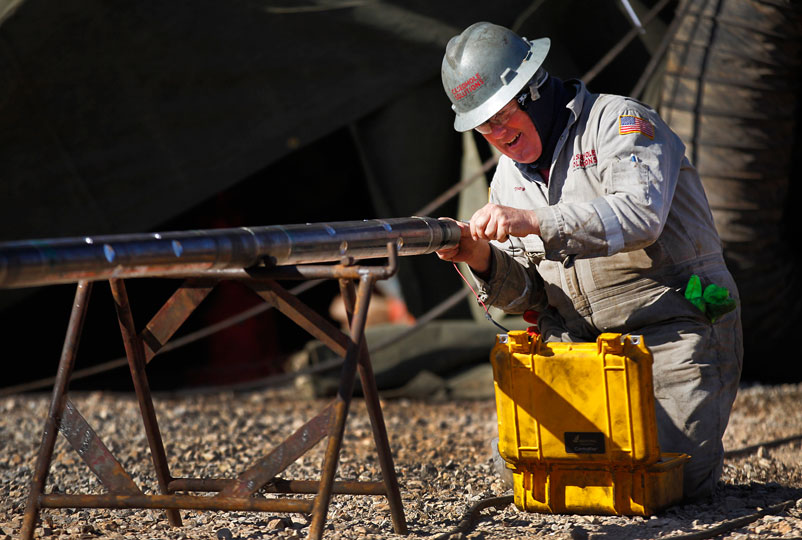

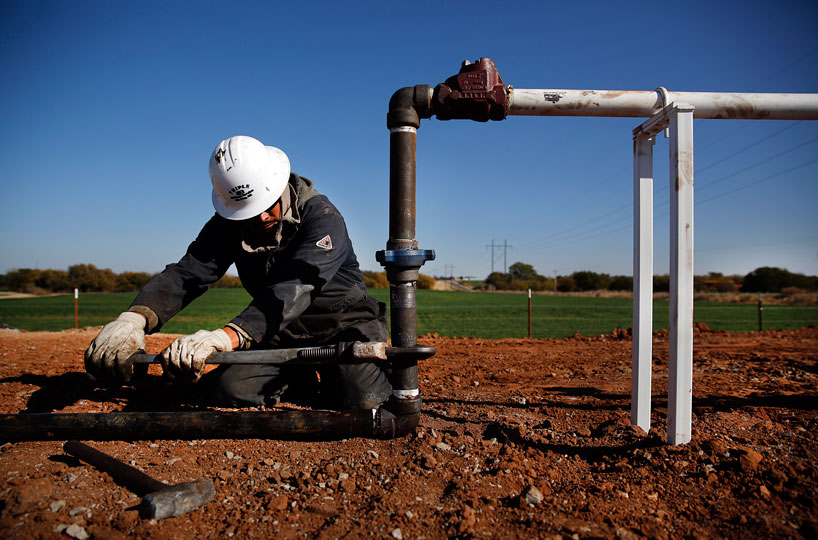
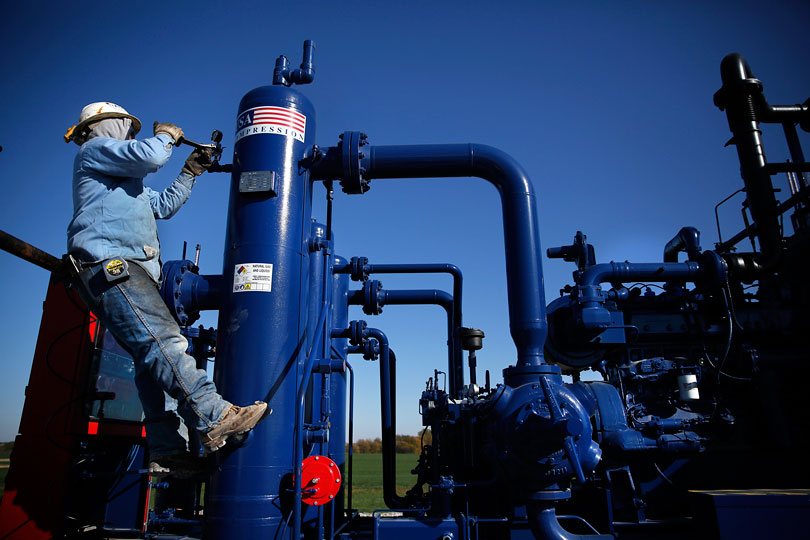
Triple B Oil Field Services employee Roymundo Noriega attaches a compressor gauge to Newfield Exploration Co.'s Peters 1H-15X site in Canadian County, Oklahoma.
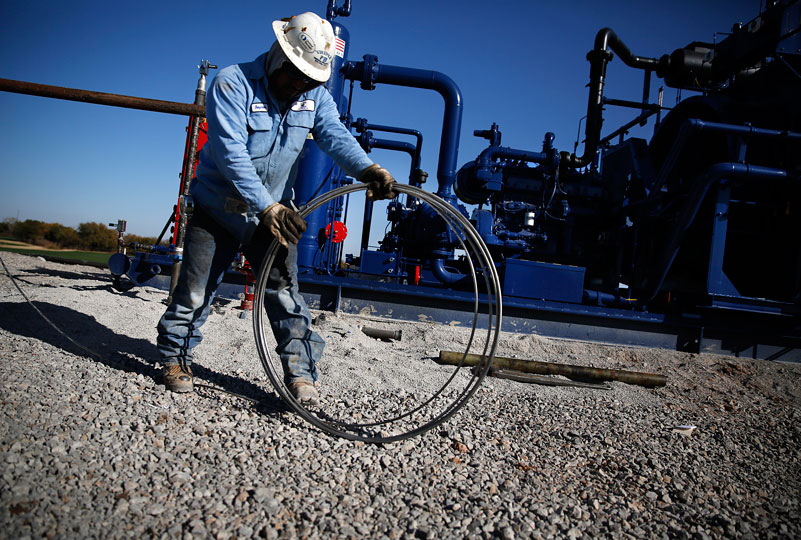

Okarche, Oklahoma.
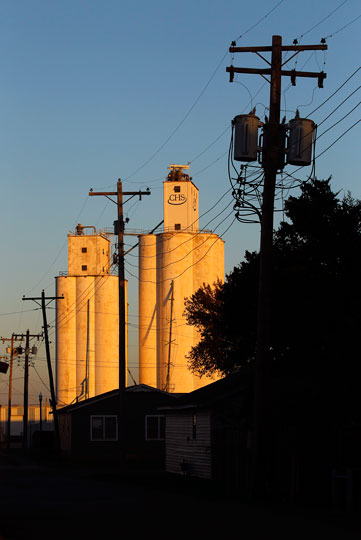


A ‘double Scoop’
Continental’s target within the Springer group is the Goddard Shale, a self-sourcing reservoir, Jack Stark, president and COO, said. The company is well on its way to HBPing its Scoop leasehold with 25 rigs at work as of mid-November—10 drilling the Springer; the balance, the underlying Woodford.

“Scoop has evolved into another world-class resource play in North America and another, major platform of growth for Continental,” Stark said. The company, which was producing 122,000 boe/d from the Bakken and Three Forks in the Williston Basin, estimates its combo Woodford/Springer holds almost as much net, unrisked, resource potential for it as the former formations: more than 4 billion boe (Bboe).
“And it’s still growing,” Stark added. Springer itself “competes head to head with the Bakken and we have excellent wells in the Bakken.”
The Springer fairway is a northwest/southeast swath in the middle of the Scoop fairway, where Continental has already drilled more than 150 Woodford wells in a four-year-old program. Beginning at about 11,000 feet, the Springer sits between 1,000 and 1,500 feet above the Woodford, which is as deep as 15,000 feet in the Scoop area.
Sohot

“When you’re drilling a Woodford well, you get a free look at the Springer on your way down. The Springer discovery was a classic, grassroots exploration effort by our team. It took about two years to do the research and drill the discovery, step-out and delineation wells,” Stark said.
“The team recognized key characteristics, suggesting the Springer could be harvested by horizontal drilling. Delineation was aided by thousands of wells that have been drilled in the past.”
The average EUR per one-section well—a roughly 4,500-foot lateral—is 940,000 boe, making for a rate of return of 80% at $80 oil and $3.50 natural gas; Scoop-Woodford wells make 60% in the condensate window and 22% in the oil window. In the Bakken, the return is about 40% at $80 and $3.50.
Of Continental’s 15 Springer wells, only two are on artificial lift, Stark added. “The majority are still flowing.”
Continental’s Scoop leasehold is 471,000 net acres prospective for the Woodford and 195,000 net for the Springer for a total of 666,000 net. In its de-risked portion of the Springer, it estimates it holds 215 net, 399 gross, locations.
Additional zones may be commercial with laterals as well, he said: the Meramec, Caney, Viola, Hunton and Hoxbar. “The potential of this area is still great, even after producing for more than 100 years.” Among fields in the area, Sho-Vel-Tum, which was discovered in 1905, has made some 1.4 Bbbl. It and other fields have produced more than 3 Bbbl from the area, combined.
“The majority of that oil has been sourced from the Woodford,” Stark said. And research suggests that up to 80% of the hydrocarbons generated in the Woodford and other source rocks there remain in these rocks. “That indicates there is a lot of oil in place to go after.”
As for well density, most of the Woodfords have been landed in the uppermost portion of the section where the formation is thinner in the area; where it is thicker—up to 400 feet—Continental anticipates placing laterals in both the upper and lower portions.
To tap the 50- to 75-foot-thick Goddard member of the Springer, Continental will drill these from Woodford pads in the future, Stark said. Communication between Springer and Woodford production is not likely, since the formations are 1,000 to 1,500 feet apart. “You have good frack barrier above and below the Springer.”
The completion recipe is the same for the Springer as for the Woodford—slickwater, sand and spacing of some 300 feet between stages. Laterals to date in the Springer have been one section; the company was spudding a 7,500-foot-lateral test at press time. Strike is the same in the Woodford and Springer—mostly in a north/south pattern.
Continental produced 36,346 net boe/d in the third quarter from its Scoop. The Springer is “like getting a ‘double Scoop,’” Stark said of the combo play. “And there are other zones in here that we will prove to be productive [with horizontals] as well.”
Vitruvian too
The Springer’s Goddard Shale has fascinated Richard Lane. Lane, a geologist, was president, E&P, for Southwestern Energy Co. during its discovery and development of the Fayetteville Shale in the 2000s. “It seems to be a very robust source rock,” he said of the Goddard.
Devon Meramec

Retiring from Southwestern, Lane went on to form Vitruvian Exploration LLC and focused on Oklahoma’s Mississippian Lime play. He sold that in 2012 and formed Vitruvian Exploration II LLC. Following formations south of the limestone play, Vitruvian II bought 350 old vertical wells in the condensate window of what Continental soon named Scoop.

Dry gas flows easily from shale using modern completion techniques. Condensate does as well, as it leaves the shale as a gas and becomes a liquid as it approaches surface pressure and temperature. But oil is a big molecule; past understanding was that it would flow from a super-tight rock only if that rock was “shaley” rather than shale like the Barnett. “But we’re seeing some areas where that’s just not the case,” Lane said. “That’s why you see something brand new like this.”
What’s different? “I don’t think we’re fully appreciating the impact the kerogen has—the type of kerogen, how the kerogen is dispersed in the rock—and some other factors that influence the oil-in-place numbers and the producibility of the rock. I don’t think it is fully appreciated yet,” he said.
“This shale is producing true oil—not just condensate.”
Goddard Shale porosity is about 6%, he said, which is about the same as Woodford porosity in the Scoop area.
Vitruvian II holds 40,000 net, contiguous acres for the Woodford in Scoop in the old Chitwood-Knox Field area in Grady, Garvin and Stephens counties that has produced from formations all along the stratigraphic column. In Vitruvian II’s block, its position is mostly operated and the Springer is thicker—about 100 feet—than east, where it has small, nonop interests in many of Continental’s wells and wells operated by Newfield and Marathon.
COO, Vitruvian
“We’re excited about that [thickness] because the wells that have already been made are pretty darn good,” Lane said. The nonop interest is low—1%, 2%, 3%—“but it’s given us a lot of data for a little over a year now. It’s a lot of wells, but it’s a small amount of capital for all the learning we’ve had.”
Held by old wells, about 95% of Vitruvian II’s position is HBP. Of its 40,000 net acres for the Woodford in Scoop, some 25,000 include rights to the Springer that is producing 80% to 90% liquids adjacent to Vitruvian II’s position. Of this, about 65% is oil.
“We wanted an asset that had diversity in its revenue stream. We are selling gas, NGL and condensate and that acts as a hedge against individual commodity cycles like we are experiencing now,” Lane said.
As for Vitruvian’s timing for exit, Lane says, “We have a great team in place, an HBP asset and more formations to explore. During 2016, it starts to cash-flow itself. But, as a private-equity-backed firm, we are always for sale at the right price.”
That’s for both its Woodford and Springer potential. It had five rigs drilling the Woodford in the fourth quarter; this year, it plans to assign one of these to drill its first operated Springers. Overall, its portfolio is producing 55% gas and 45% liquids. A large portion of its liquids production is hedged for 2015.
Granite Wash West

“But we don’t make our capital investments based on one year of revenue when we have 30-year-plus reserves,” Lane said. “And we’re in one of the lowest breakeven plays in the U.S. Scoop-Woodford is one of the last to go and the Springer is even better. And it’s HBP, so we can always taper back what we’re doing and not worry about leases expiring.”

Oklahoma City, Oklahoma.

Devon Tower seen behind SkyDance Bridge, a 197-foot-tall sculpture and pedestrian bridge that spans Interstate 40 in Oklahoma City, Oklahoma.





Oklahoma City from the Devon Energy Tower.



Devon employees walk across the 'Nautilus' spiral design of the rotunda floor of the Devon Energy Tower in Oklahoma City, Oklahoma.
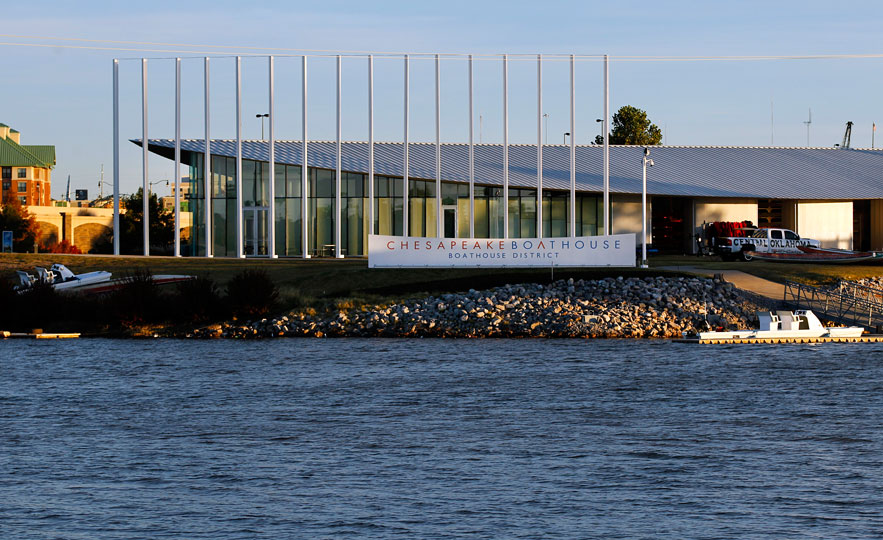
The Oklahoma City Boathouse.



Pre-game activities before an NBA Oklahoma City Thunder basketball game against the Sacramento Kings at Chesapeake Energy Arena.
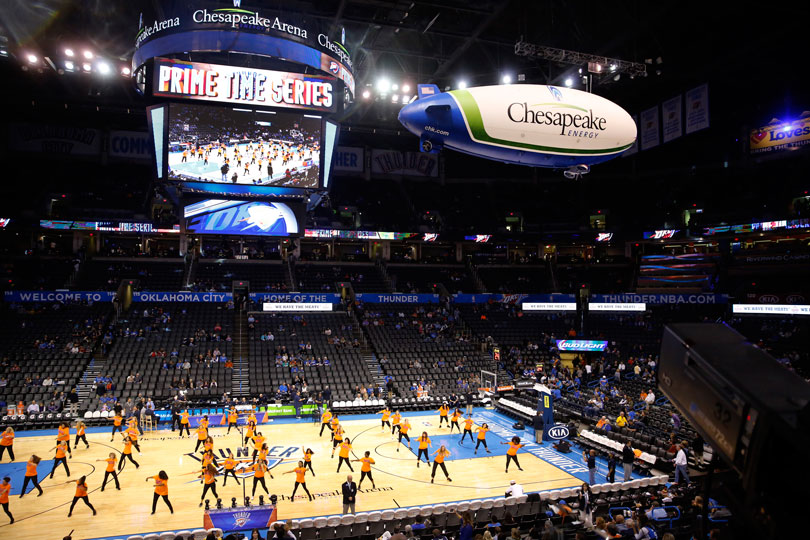

American Energy Partner CEO (former Chesapeake Energy CEO) Aubrey McClendon and family enjoying a Thunder game.


The Skydance Bridge’s soaring architecture was inspired by Oklahoma’s state bird, the scissor-tailed flycatcher.
The position contains Meramec too, which is known as Sycamore in the Scoop area. And there is horizontal potential in other zones, including the underlying Hunton. Vitruvian II had an unexpected look at the Hunton in one of its Woodford wells.
“We got out of zone,” Lane said. “We were drilling the lateral in the middle of the Woodford, but you get out of zone every once in a while when your reservoir is at 15,000 feet. We had huge shows coming out of the Hunton. It could be more fractured. Could it be a target? I don’t know how much we will get to [testing before exiting].”
He expects Vitruvian II’s position has room for more than 650 operated Woodfords and Springers. The company expected to exit 2014 with 10,000 boe/d of production, 60% gas and 40% oil and NGL. Its 2015 plan is for 25 more Woodford wells and five Springer.
Orogrande Wolfcamp

The Woodford wells cost $9.5- to $14 million “depending on the lateral length and who’s drilling them. It’s coming down, though,” he said. The Springers, at a shallower depth and with only one-section laterals yet, cost about $9.5 million on average.
Lane deems Scoop’s Woodford and Springer “some of the best rock we’ve seen anywhere and some of the highest-volatility, unconventional rock we’ve come across. Deliverability is really high. The economics are fantastic.”

Sohot
In 2014, Unit Corp. announced the “SoHot” play. It targets sandstone intervals within the roughly 3,000-foot-thick, Pennsylvanian-age Hoxbar overlying the Springer and Woodford on the western edge of Scoop in Grady County. “SoHot” is derived from “southern Oklahoma, Hoxbar oil trend.”
For this year, Unit plans three rigs to drill some 20 wells and estimates gross potential of 300 to 400 wells in its SoHot position of some 12,000 net acres, it reported.
Its Medrano-sandstone, horizontal discovery was drilled in 2011: the one-section Claiborne 1-4H at about 9,800 feet. A 2014 well, Cody 1-36H, had a 30-day IP of 240 bbl of oil and 3.7 million cubic feet (MMcf) of gas a day. The wells cost about $5 million each.
Unit expects it has some 300 Medrano locations, according to an investor report. EUR per well is 526,000 boe, 33% liquids. Payout is less than two years.
Just below Medrano, the oilier Marchand sandstone at about 11,000 feet has a rate of return of 410%, it reported. The one-section wells have an EUR of about 440,000 boe, cost about $7 million, produce 89% liquids of which 80% is oil, and pay out in less than a year.
Unit plans to test the Culp member underlying Marchand this year. It also has potential for Springer pay and plans a test four miles west of Continental’s Wilkerson 1-20H, which IPed 2,038 boe from the Springer.
Far below, the Woodford Shale in its SoHot area is in the gas window, however.
Brad Guidry, executive vice president, E&P, said in a third-quarter earnings call, according to a SeekingAlpha.com transcript, “All three Marchand producers had an initial 30-day rate in excess of 1,000 barrels of oil equivalent per day at 1,306 boe, 1,581 and 1,414.”
Each was fracked with some 4.1 million pounds of sand, he added.
The average IP was 86% oil. “The three Medrano wells also had initial 30-day rates in excess of 1,000 barrels of oil equivalent per day at approximately 1,458, 1,037 and 1,395.” Production averaged 70% gas. Two were fracked with 1.3 million pounds of sand each; the third, with 3 million. A fourth was fracked with 4 million “and we are very encouraged with their early flow-back results,” Guidry said.

Devon Meramec
Devon Energy Corp. began developing the Woodford play in Cana Field in 2007 in the east-central Anadarko Basin just northwest of Oklahoma City. Chairman Larry Nichols noted in The American Shales (2014) that, in the Gulf of Mexico, the company could spend $200 million net to its interest in deepwater wells that might not go into sales for as many as 10 years and could be a dry hole. Instead, Devon looked again onshore—just outside its Oklahoma City headquarters—at the Woodford Shale. “It’s oil and it’s in Oklahoma,” Nichols said.
Devon’s third-quarter net production from the Woodford play was 73,000 boe/d, 42% liquids. In its 300,000-net-acre position—which is mostly HBP now by some 800 wells and with more than 5,000 additional, risked locations—the oily Meramec appears in some 35,000 net acres, said Todd Moehlenbrock, Devon vice president, Anadarko Basin business unit.

Devon had drilled two wells in the Meramec by mid-November, was completing the first of them at press time and was preparing to complete the other one, which has a two-section lateral. It plans five or so more Meramec wells this year.
“We’re very excited about it,” Moehlenbrock said. “It has what looks like some very attractive oil potential.”
Cimarex Energy Co., a partner with Devon in an area it has dubbed “East Cana,” has also drilled the Meramec and has a large program planned for 2015 as well. Cimarex’s total position for the formation is 70,000 net acres, 86% HBP, and it drilled seven tests in 2014. Its first test had a 30-day peak IP of 9.4 MMcfe, including 306 bbl of oil, a day.
Cimarex’s wells in the gassier area of the Meramec have been “pretty good” too, Moehlenbrock said. “And we’re watching Newfield, which is the leader in the Stack area, and understanding their data,” he added. “The oil rates are very attractive and our early look at this is that it is going to be a commercial play.”
Legacy infrastructure is throughout Oklahoma and Devon has put in additional infrastructure for Cana Field’s Woodford production. So adding the Meramec isn’t greenfield; it’s gravy.
“We do have the infrastructure,” Moehlenbrock said. “We have a team. We have an office in Weatherford. We could easily expand our operations. It’s a bolt-on. We can easily scale up, and that makes it even more attractive.”

Granite Wash West
Apache Corp. has increased potential-well estimates in its new Canyon Lime play in Texas’ legendary Panhandle Field, which has produced more than 1.4 Bbbl of oil and 8.1 trillion cubic feet (Tcf) of gas, beginning in 1910.
At between 7,500 and 9,500 feet, the pay in the Canyon Wash is between 100 and 580 feet thick, according to an Apache report. Porosity is 6% to 10%—similar to that of Apache’s Wolfcamp in the Permian Basin; total organic carbon (TOC) is also similar at 2% to 6%. The liquids yield is roughly 1,000 bbl of oil per 1 MMcf of gas, which is slightly higher than its highest-end Wolfcamp wells. About 50 miles west of the ongoing Granite Wash program, in 2014 the company added 29,000 net acres to its Canyon Lime play—in Oldham and Potter counties at the intersection of the Dalhart, Hugoton and Anadarko basins—to total 130,000 net by mid-November.
In Potter County, its Canyon Lime discovery, Bivins East 41-1H, which was out of zone in some 75% of the 5,500-foot lateral, had a 30-day IP of 787 boe/d. First-seven-month oil production was 54,286 bbl.
Its Bivins East 94-1H had a 30-day IP of 1,718 boe/d from 4,500 feet of lateral. First-six-month oil production was 80,087 bbl.
Pay is possible from additional zones in the leasehold, the company reported. In Canyon Lime alone, Apache estimates it has 800 locations at 600-foot spacing, according to its mid-November investor presentation. It had four rigs drilling the formation in fourth-quarter 2014 and planned to add a rig this year, making a total of 35 horizontals in 2015. The one-section wells cost about $8.5 million each, according to the company.
At the southernmost end of the Hugoton Basin, Panhandle Field has produced from Pennsylvanian- and Permian-age, conventional formations. Canyon Lime is part of the Canyon group of Pennsylvanian age.
Meanwhile, Apache had cut its rig count in the adjacent Anadarko Basin, where it had been drilling for Granite Wash and Tonkawa pay. It had a $625 million agreement at press time to sell some of that position, involving some 115,000 net acres.
Equity analysts with Tudor, Pickering, Holt & Co. noted in mid-November that Apache’s 2015 Midcontinent budget had been cut in half to some $600 million from 2014, with most of what is remaining devoted to Canyon Lime. “We understand the company is encouraged by initial well results in the Canyon Lime, but we think this play will be in ‘show me’ mode for the next six-plus months, given limited delineation and a subpar track record elsewhere in the … region,” they concluded.

Orogrande Wolfcamp
Micro-cap Torchlight Energy Resources Inc. is commencing exploration to 6,000 feet in the Orogrande Basin, which is a depositional twin to the Midland Basin, about 25 miles northeast of El Paso, Texas.
“We have about 1,300 feet of net pay in the prospect,” said Will McAndrew, COO. Wolfcamp is among targets; however, four initial vertical wells will analyze the length of the stratigraphic column. Geologist Rich Masterson, who developed the idea of a Wolfbone play in the southern Delaware Basin, also developed the Orogrande idea but, rather than selling it, he and his partners traded it for shares of Torchlight to participate in the potential upside.

The Orogrande Basin, which is in New Mexico and Texas, currently produces oil and gas from about 2,300 feet. Yates Petroleum Corp. drilled five verticals in the early 2000s to about 7,000 feet on the Texas side for conventional, gas-loaded sands that did not appear. Logs showed about 1,300 feet of siltstone, instead, similar to the roughly 1,400 feet of siltstone that includes the Wolfcamp in the Midland Basin.
Torchlight now holds 172,000 gross, University of Texas acres—with about 140,000 of this in a block leased for about $20 an acre and a 25% royalty—in Hudspeth County, Texas. The primary term is five years; the option is for a five-year extension.
“So we have the entire basin leased,” McAndrew said.
Plano, Texas-based Torchlight’s working interest is 100%; Masterson and partners have a 10% back-in option. The four-exploration-well plan will offset three of the Yates wells as well as a Texaco well that was drilled in 1991. Although vertical, they will cost some $1.5 million each; this includes logging, coring and analysis. “We’ll give Rich all the science he needs,” McAndrew said. If activity proceeds, vertical development wells are expected to cost less than $1 million each.
McAndrew explained that the Delaware, Orogrande and Midland basins were connected at one time. “With structural occurrences, they divided into three basins. The Orogrande is a twin to the Midland Basin.”
Cuttings on file with the university’s samples library in Midland indicate sweet oil with 40- to 43-degree gravity below 4,000 feet and, at about 6,000 feet, 1,500-Btu gas and 48- to 50-degree crude.
Torchlight is planning to sell its South Texas leasehold and wells that are prospective for Eagle Ford, Austin Chalk and Buda. It is also selling its central Kansas acreage that is producing from Maquoketa dolomite.
It will continue in its joint venture with Husky Ventures Inc. in a Hunton play in Kingfisher County, Oklahoma, as well as in a JV targeting Mississippian pay with Ring Energy Inc. in southwestern Kansas.
“In the Orogrande, if only 60% of the 172,000 acres are productive—and we have vertical control for at least half of it—that gives us [and Masterson et al.] 2,500 wells on 40-acre spacing. It’s a lot,” McAndrew said.
In the Oklahoma play, other operators are landing wells in additional formations, such as the Woodford and Meramec, overlying the Hunton. McAndrew said those are additional targets for Torchlight and Husky. “Husky is drilling some monster wells in the Hunton—68 successful wells in a row; no dry holes. Everything uphole is HBP. The Hunton wells are paying out in under a year. Why not start at the bottom and work your way up?”
Recommended Reading
Comments
Add new comment
This conversation is moderated according to Hart Energy community rules. Please read the rules before joining the discussion. If you’re experiencing any technical problems, please contact our customer care team.


